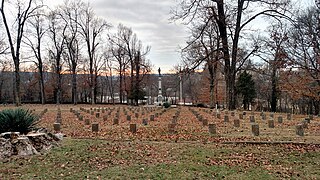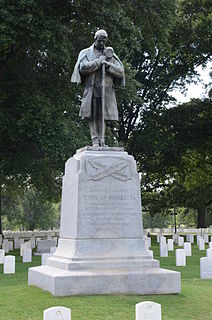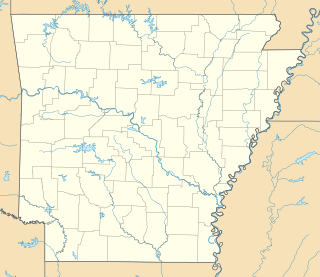
Mount Holly Cemetery is a historic cemetery located in the Quapaw Quarter area of downtown Little Rock in the U.S. state of Arkansas, and is the burial place for numerous Arkansans of note. It was listed on the National Register of Historic Places in 1970 and has been nicknamed "The Westminster Abbey of Arkansas".

The Old State House, formerly called the Arkansas State House, is the oldest surviving state capitol building west of the Mississippi River. It was the site of the secession convention, as well as the fourth constitutional convention when delegates agreed to ensure voting rights for freedmen and establish public education.

The Arkansas State Capitol, often called the Capitol Building, is the home of the Arkansas General Assembly, and the seat of the Arkansas state government that sits atop Capitol Hill at the eastern end of the Capitol Mall in Little Rock, Arkansas.

Little Rock National Cemetery is a United States National Cemetery, located two miles (3 km) south of the city of Little Rock, in Pulaski County, Arkansas. It encompasses 31.7 acres (12.8 ha), and as of the end of 2005, had 25,172 interments. Administered by the United States Department of Veterans Affairs, it is currently closed to new interments.

The Civil War Memorial, in the DeKalb County county seat of Sycamore, Illinois, United States, is located in front of the DeKalb County Courthouse on a public square. The memorial was erected in 1896 and dedicated in 1897. The structure is a memorial to the thousands of DeKalb County residents who served in the American Civil War. It incorporates an obelisk which rises to 50 feet in height. The base is adorned with copper sculpture, completed by an unknown sculptor. On the east facade of the memorial the word "Antietam", denoting the Battle of Antietam, is misspelled. This work of public art underwent its first restoration work in 2005-2006.

David Owen Dodd, also known as David O. Dodd, was an Arkansas youth executed for spying in the American Civil War.

The Cuban Friendship Urn, also known as the Cuban–American Friendship Urn or USS Maine Memorial, is a marble statue in Washington, D.C., listed on the National Register of Historic Places. The monument originally stood in Cuba to honor the American deaths aboard the USS Maine during the Spanish–American War in 1898.

Fayetteville Confederate Cemetery is a cemetery for soldiers of the Confederate States located on the eastern side of Fayetteville in Washington County, Arkansas. Added to the National Register of Historic Places (NRHP) in 1993, the cemetery encompasses 3.5 acres (1.4 ha).

The Camden Confederate Monument, also known as the Confederate Women's Memorial, is located on the grounds of the Ouachita County Courthouse in Camden, Arkansas. The sculpture, carved out of Italian marble, depicts a woman dressed in the period of the American Civil War, standing with her feet together, clutching a flagpole. The sculpture is mounted on a block of North Carolina granite, next to a tall obelisk. The statue is 5 feet (1.5 m) tall. The obelisk is inscribed on three sides, recognizing the valor of women in the Confederate cause, and the organizations that funded the memorial's construction. The memorial was erected in 1914 by the local chapters of the United Confederate Veterans and the United Daughters of the Confederacy.

The Arkadelphia Confederate Monument is located on the grounds of the Clark County Courthouse in Arkadelphia, Arkansas. The sculpture, which depicts a Confederate Army soldier, was carved from Italian marble, and is mounted on a base of Georgia marble. It was designed and executed by R. P. Phillips in 1911, with funding from the local chapter of the United Daughters of the Confederacy.

The Robert E. Lee Monument is a U. D. C. memorial built to honor Lee County's Confederate veterans. The monument was carved by the McNeel Marble Co. It is located in Marianna, Arkansas, across from the Lee County Courthouse. Dedicated in 1910, it is one of several monuments built to honor Confederate soldiers. The structure is a local tourist attraction and, since 1996, has been listed in the National Register of Historic Places.

The Hot Springs Confederate Monument is located in Landmark Plaza in central Hot Springs, Arkansas. It is a marble representation of a Confederate Army soldier, manufactured by the McNeel Marble Company of Marietta, Georgia. The figure is 6 feet (1.8 m) tall, and is mounted on a granite base 12 feet (3.7 m) tall and 6 feet square. The monument was placed in 1934 by the local chapter of the United Daughters of the Confederacy, and was the last Confederate monument placed in one of Arkansas' major cities.

The Arkansas Confederate Soldiers Monument, also known as Defense of the Flag, is located on the east side of the Arkansas State Capitol grounds in Little Rock, just off 4th Street. It is a five-tiered marble structure, topped by a bronze statue of an angel standing on a sphere, and a bronze Confederate Army soldier on the front of its fourth tier. It was built in 1904–05, with funding from a variety of sources, including the state, primarily through the efforts of a consortium of Confederate memorial groups. Originally located prominently near the main eastern entrance to the capitol building, it was later moved to its present location on the northeast lawn.

The Pine Bluff Confederate Monument has long been located in front of the Jefferson County courthouse, at Barraque and Main Streets in Pine Bluff, Arkansas. It depicts a standing Confederate Army soldier, holding a rifle whose butt rests on the ground. The statue, built out of Georgia marble by the McNeel Marble Company, stands on a stone base 15 feet (4.6 m) in height and 10 by 10 feet at the base. It was placed in 1910 by the local chapter of the United Daughters of the Confederacy.

The Little Rock Confederate Memorial is a stone memorial marker in Little Rock National Cemetery, Little Rock, Arkansas. Set in an overflow area of the cemetery on 21st and Barber Streets, it is a granite obelisk, mounted in a concrete base, measuring 18 feet (5.5 m) in height and a square base 67 inches (1.7 m) per side. Midway up the west side of the obelisk "U.D.C." is inscribed, with "1913" at the base of that side. Inscriptions on the sides of the base commemorate fallen Confederate Army soldiers. It was placed in 1913, paid for by the local chapter of the United Daughters of the Confederacy. The ceremony marked the first time that the federal government formally took charge of a former Confederate military cemetery.

The Memorial to Company A, Capitol Guards was an American Civil War memorial in MacArthur Park, Little Rock, Arkansas. It stood just northeast of the former Tower Building of the Little Rock Arsenal, at a junction of two of the park's internal roadways. It consisted of a bronze sculpture depicting a Confederate Army soldier in a defensive stance, holding a rifle pointed forward. The statue was 8 feet (2.4 m) in height, and was mounted in a granite column 16 feet (4.9 m) tall. The memorial was sometimes known as "Lest we forget", a line that appeared near the top of the inscription on the base. The statue was created by sculptor Rudolph Schwarz, and was installed in 1911; it was paid for by the local chapter of the Sons of Confederate Veterans, and memorializes the unit that seized the arsenal at the outset of the war.

The Minnesota Monument is an American Civil War memorial in the Little Rock National Cemetery in Little Rock, Arkansas. Also known as "Taps", it depicts a Union Army soldier, his bare head slightly bowed. His hands resting on the butt of his rifle, which is inverted, with the barrel resting on the ground. The bronze sculpture is 7 feet (2.1 m) tall, and is mounted on a granite base about 8 feet (2.4 m) tall. It is dedicated to the 36 soldiers from Minnesota who are buried here. The sculpture was designed by John Karl Daniels, and was funded by the state of Minnesota. It was dedicated in 1916.

The Monument to Confederate Women, also known as the "Mother of the South", is a commemorative sculpture on the grounds of the Arkansas State Capitol in Little Rock, Arkansas. It depicts a mother and two of her children saying goodbye to an older son who is dressed in a Confederate uniform. The sculpture is cast in bronze, and stands over 7 feet (2.1 m) in height. It is mounted in a multi-tiered pedestal, nearly 12 feet (3.7 m) in height, with sections made of concrete, granite, and marble. The statue was created by J. Otto Schweizer, and was dedicated in 1913. It was funded by the United Confederate Veterans.

The Gentry Grand Army of the Republic Memorial is an American Civil War monument in the northeast section of Gentry Cemetery in Gentry, Arkansas. It is a limestone structure with Classical Revival features, consisting of a stepped square base, a tier of marble panels framed by round columns, and a tapered obelisk topped by a carved capital and round knob. Two of the marble panels are inscribed with the names of soldiers who served in the Union Army. The monument was installed in 1918 through the efforts of David Kost, a Civil War veteran who organized Gentry's chapter of the Grand Army of the Republic (GAR). It is one of a relatively small number of GAR memorials in the state.





















